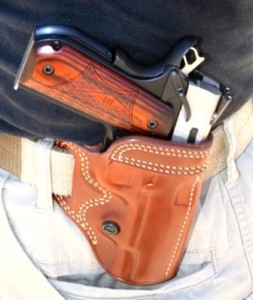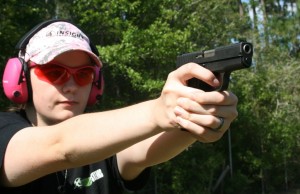Navigate This Post
This morning I had a meeting with a fellow business professional. In addition the business at hand, the topic turned to guns and concealed carry. My friend is a military veteran with some experience as a “Special Investigator” with a government agency, but he hasn’t carried a gun on a regular basis for nearly twenty years.
The specifics of our discourse focused on concealed carry for himself and for his wife. We decided that they both needed to get into our next Armed Living class. Naturally, there were several follow up questions. “What kind of gun should I get for my wife? Where can I find eye and ear protection? What ammunition is best for self-defense?”
Have you rated us on iHeartRadio yet?
Click Here to “Heart” us and Leave a Comment below the episodes >>
As I make my living dealing with all things firearms related, I have to remind myself that there are likely thousands of people asking those questions each day. During this week’s contribution, we will spend some time addressing these queries.
Guns for Husbands and Wives

Let women choose their own gun.
Step number one, if you are a husband recommending a gun to your wife you need to keep in mind that it is HER gun, not an extra one for you. Wives are not necessarily going to appreciate your favorite blaster to the extent you do. Take your wife to the gun store and the range and let her feel and try out handguns. And no, this is not an excuse for you to give your wife an old gun and buy a new one for yourself.
Women, don’t be shy. I know that gun stores reek of Old Spice and testosterone, but get in there and start asking questions. Wrap your dainty paws around some blue steel and see what you like. Better yet, go to an indoor range and rent a gun or two or three and try them out. Don’t be afraid of buying the wrong gun. If you find that you do not like a gun, you can trade or sell it back to the shop with little trouble.
Holsters

Choose a quality holster, you won’t regret it.
Unless you plan to keep your gun on the shelf, you need to buy a holster for it. Keep it simple. My advice is to look for a holster that fits comfortably over your strong-side hip. Yes, there are other styles, but let’s learn to walk before we run.
As for brands and designs, buy cheap and you get cheap. A ten dollar holster will always be a ten dollar holster; that is to say, a cheap piece of marginal equipment. If you are serious about training, practicing, and carrying a gun, it makes no sense to purchase the cheapest holster you can find. Carrying a gun means just that, actually carrying it on your body, not just at the range but every day. Cheap, poorly made holsters are not secure or comfortable.
Stay away from “one-size fits none” or “universal” holsters. Purchase a holster that was made specifically for the gun you plan to carry. Step two, take that holster to the range and actually practice with it. Yes, you can practice safely removing and returning your gun to and from the holster with an unloaded firearm in your home. We strongly suggest getting some training if this is a new activity for you.
Eyes and Ears

Eye and ear protection are a must-have for live-fire training.
As firearms produce ear-damaging noise and the dirt, dust, and debris on the shooting range may harm your eyes, at our school we REQUIRE every shooter and those simply watching live-fire training to wear both eye and ear protection. Ear protection varies from disposable foam plugs to rubber plugs to earmuffs. Electronic hearing protection muffs, that cut out the harmful gunfire noise but amplify the sound of your instructor’s voice, are an excellent choice for training. These electronic muffs have also come down in price over the last several years. A quality set can now be had for around $50.
Regarding eye protection, shatter-proof glasses that wrap around the shooter’s head are the way to go. Regardless of the brand or style, eye protection is a must-have on any shooting range, even if you are just spectating.
Ammunition Choices
Practice
Practice or target ammunition is purposely built to be less expensive. In today’s world, there is no such thing as ‘cheap’ ammunition but there is ammunition that is more ‘cost effective’. Training or practice ammunition is purposely built with less expensive components. By using less expensive components the manufacturer is able to reduce the consumer cost thus allowing you to shoot more for less money. Practice ammunition will be loaded with full metal jacket (non-expanding) or solid lead bullets and the cases will be standard brass, lacquered steel or aluminum.
Fighting

Self-Defense ammunition is more expensive for a reason.
When a manufacturer produces a fighting load, one that the shooter will be using to protect their life, they use premium or more expensive components. A quality defensive load will have a controlled expansion bullet. These come in many varieties but all are designed to expand/open up when they strike something solid like animal tissue. The reason for this is two-fold, expanding bullets reduce the chance of the bullet passing completely through the target and they also will potentially do more damage to the target thus reducing the number of rounds it takes to neutralize the threat.
If you are truly stumped as to what defensive load to buy, simply make inquiries and find out what the local constabulary are toting. Buy that brand of ammo and load up your gun. Actually, purchase a bit more than you think you will need so you can test it out in your gun. You want to have confidence that your gear will function when it is supposed to.
Parting Thoughts
We understand that there are thousands of gun owners who have not been gun carriers. Carrying a gun requires more dedication and effort than simply purchasing one and locking it in a safe until range day. For you first-time gun carriers, our advice is simple; seek out professional training, ask valid questions, and then listen.
Professor Paul Markel
Latest posts by Professor Paul Markel (see all)
- Tactical Masturbation: Top 3 Stupid Human Tricks - July 8th, 2024
- Blood Trail: Fearless Fiction - June 21st, 2024
- SOTG and SB Tactical Celebrate Brace Ruling - June 20th, 2024
- Shotgun Accessories: Practical and Useful - June 14th, 2024
- Tactical Rifle Tips: Transition Drills - January 5th, 2024






Guys,
I live in NYC so the odds of me getting a CCW are pretty remote unless I can prove to NYPD that I deposit a billion dollars a week at the local ATM (I am in a cash business so it’s not impossible … well, not a billion), but it seems that every week you report on CCW holders who have used their guns in self defense and end up in jail and subsequently fighting the legal battle of all times just to return to a semi-normal (yet financially ruined) life.
Along with the ability to save your life you’re also walking around with the ability to totally ruin it based on a judge or jury decision. If you’re going to carry it, as you say, you have to have made the decision to use it if need be.
It makes my head spin to think of the consequences of saving ones, (or others), lives.
Any comments to first time CCW carriers about thought processes?
The media likes to play up “bad shoots” or questionable issues. We do the Go Team Moment on the radio almost every week and those people are not normally ever charged.
Your other option to being armed and prepared is to simply allow yourself to become one of thousands of faceless victims, a statistic for politicians to discuss.
The only person responsible for your safety is you.
Using a gun in self defense will change your life. Not having a gun if you need to defend your life could very well end your life.
Getting proper training and regular practice can prepare you for both self-defense fights, the one for your life, and the one for the rest of your life.
The choice is yours and if you think about it, that choice is scary, either way you go.
I chose to preserve my options, something you won’t have without a gun should you ever need it.
I agree with both of you. The option to have a ruined life ends if you’re dead. It wasn’t so much about a choice to defend or not defend but the thought about what comes after … as is written and talked about so much. I don’t mean media, I mean by guys like Mas, et al.
My point was that for those of you who have carried with as much (or little) thought as I use to put a pen in my shirt and bandana in my pocket, you can sometimes lose the … hmmm, weighty-ness if that’s a word, of all of a sudden having this immense power and responsibility on your hip.
In NYC, (as is for those in NJ), I can only go TO and FROM the range. No grabbing a water or sandwich on the way. Carrying *A* gun in my car in nyc, (with all the legal requirements met … of course), just got me to thinking what it would be like to legally carry concealed and the initial thoughts that go with that.